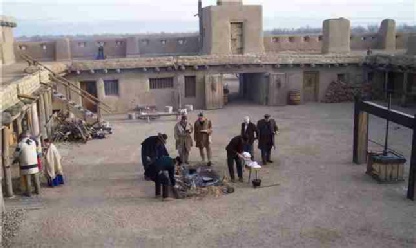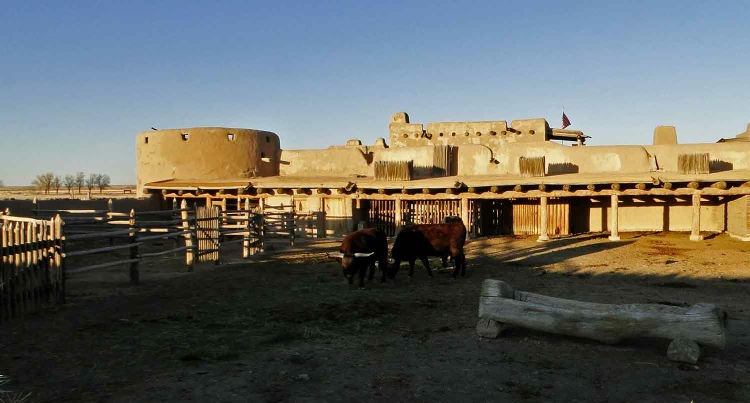Mountain Men and Life in the Rocky
Subject Guide

Mountain West
Malachite’s Big Hole
Bent’s Fort:
Bent’s Fort (then usually known as Fort William) was established in 1833 by William and Charles Bent, along with Ceran St. Vrain (the Bent, St. Vrain & Co.) to trade with plains Indians, trappers and travelers along the Santa Fe Trail. For much of its sixteen year history, the fort was the only permanent post along the Santa Fe Trail and it became a major stopover point between St. Louis and the Mexican towns of Taos and Santa Fe. The fort was built on the north side of the Arkansas River near the present day community of La Junta, Colorado. At the time the fort was constructed, the Arkansas River marked the boundary between territories of the United States and Mexico. Because of its intermediate position between Mexico and the United States, the fort quickly became a trading center for goods, supplies and manufactured items passing between the United States and Mexico, as well as a staging point for goods to be moved northward for the fur trade along the front range of the Rocky Mountains.
post along the Santa Fe Trail and it became a major stopover point between St. Louis and the Mexican towns of Taos and Santa Fe. The fort was built on the north side of the Arkansas River near the present day community of La Junta, Colorado. At the time the fort was constructed, the Arkansas River marked the boundary between territories of the United States and Mexico. Because of its intermediate position between Mexico and the United States, the fort quickly became a trading center for goods, supplies and manufactured items passing between the United States and Mexico, as well as a staging point for goods to be moved northward for the fur trade along the front range of the Rocky Mountains.
 post along the Santa Fe Trail and it became a major stopover point between St. Louis and the Mexican towns of Taos and Santa Fe. The fort was built on the north side of the Arkansas River near the present day community of La Junta, Colorado. At the time the fort was constructed, the Arkansas River marked the boundary between territories of the United States and Mexico. Because of its intermediate position between Mexico and the United States, the fort quickly became a trading center for goods, supplies and manufactured items passing between the United States and Mexico, as well as a staging point for goods to be moved northward for the fur trade along the front range of the Rocky Mountains.
post along the Santa Fe Trail and it became a major stopover point between St. Louis and the Mexican towns of Taos and Santa Fe. The fort was built on the north side of the Arkansas River near the present day community of La Junta, Colorado. At the time the fort was constructed, the Arkansas River marked the boundary between territories of the United States and Mexico. Because of its intermediate position between Mexico and the United States, the fort quickly became a trading center for goods, supplies and manufactured items passing between the United States and Mexico, as well as a staging point for goods to be moved northward for the fur trade along the front range of the Rocky Mountains.
The fort compound was 142 feet by 122 feet with 26 rooms and a courtyard. There were corrals, sheds, a blacksmith shop, woodshop, gunsmithing area, and even an ice house. The fort lost importance as the Cimarron Cutoff became more widely used by travelers. During the war with Mexico in 1846, the fort was used as a staging area for Colonel Stephen Kearny’s Army of the West. In response to a number of events including the death of his brother Charles in the Taos uprising, an outbreak of cholera on the eastern plains, and the failure to sell the fort to the US Government after the Mexican War, William Bent destroyed the fort in 1849.
gunsmithing area, and even an ice house. The fort lost importance as the Cimarron Cutoff became more widely used by travelers. During the war with Mexico in 1846, the fort was used as a staging area for Colonel Stephen Kearny’s Army of the West. In response to a number of events including the death of his brother Charles in the Taos uprising, an outbreak of cholera on the eastern plains, and the failure to sell the fort to the US Government after the Mexican War, William Bent destroyed the fort in 1849.
 gunsmithing area, and even an ice house. The fort lost importance as the Cimarron Cutoff became more widely used by travelers. During the war with Mexico in 1846, the fort was used as a staging area for Colonel Stephen Kearny’s Army of the West. In response to a number of events including the death of his brother Charles in the Taos uprising, an outbreak of cholera on the eastern plains, and the failure to sell the fort to the US Government after the Mexican War, William Bent destroyed the fort in 1849.
gunsmithing area, and even an ice house. The fort lost importance as the Cimarron Cutoff became more widely used by travelers. During the war with Mexico in 1846, the fort was used as a staging area for Colonel Stephen Kearny’s Army of the West. In response to a number of events including the death of his brother Charles in the Taos uprising, an outbreak of cholera on the eastern plains, and the failure to sell the fort to the US Government after the Mexican War, William Bent destroyed the fort in 1849.
A selective history of the Arkansas Valley can be found here. This is the narrative that was presented on the West Field trip of the 2015 Fur Trade Symposium.
In 1976 the fort was reconstructed using archeological evidence, original sketches, paintings and descriptions in diaries. Unlike many reconstructions, this reconstruction is located on the foundations of the original structure. So if you should visit the fort, you will be passing through the same doorways, and seeing the world much as the Bent brothers and St. Vrain, Kit Carson, James Beckwourth, Thomas Fitzpatrick, "Blackfoot" John Smith, John Hatcher, and a host of others, separated only by the passing of time.
For more information about Bent's Fort visit:
or read:
Bent's Fort. By David Lavender. Copyrighted 1954. Published by the University of Nebraska Press.
